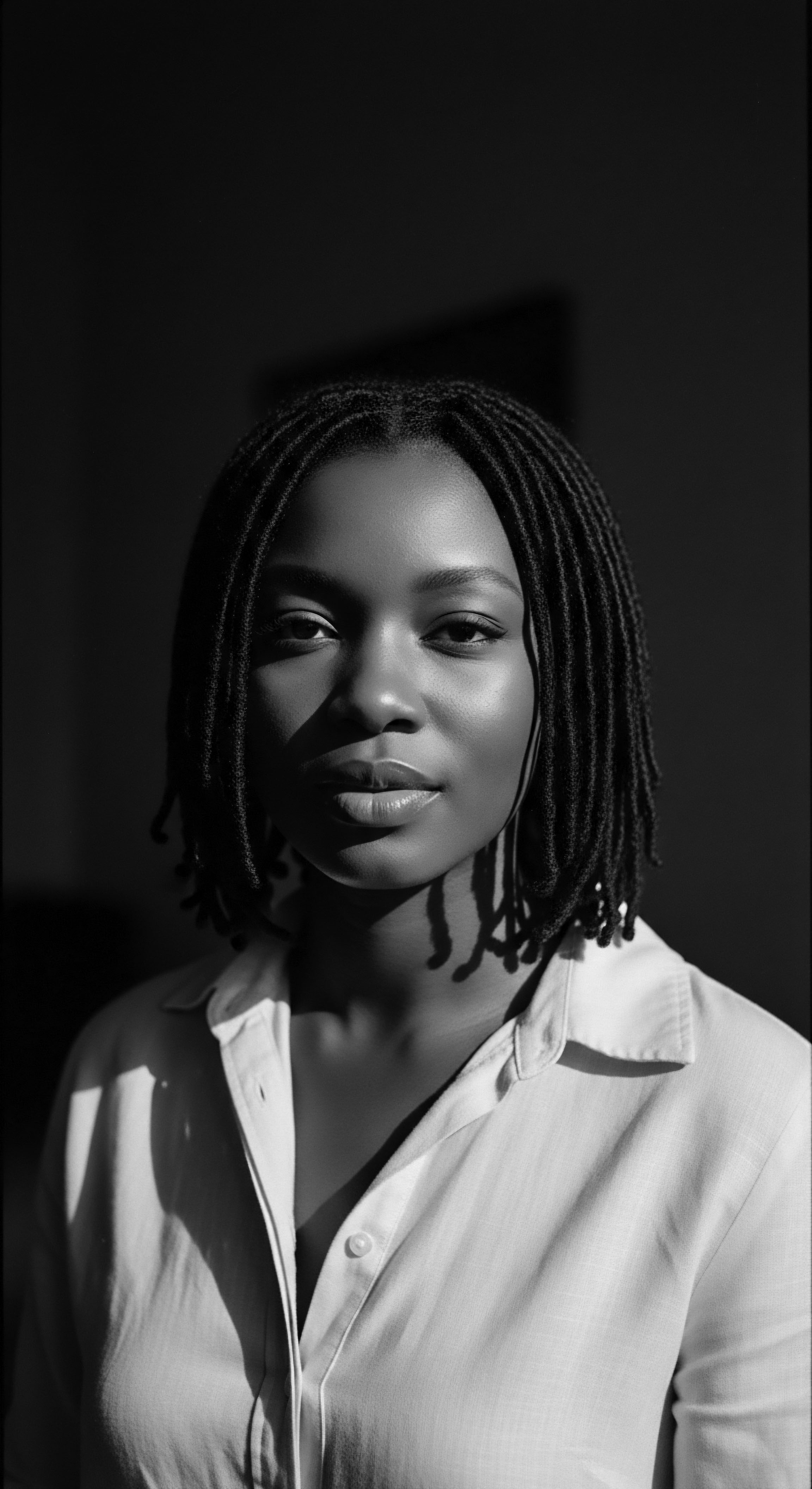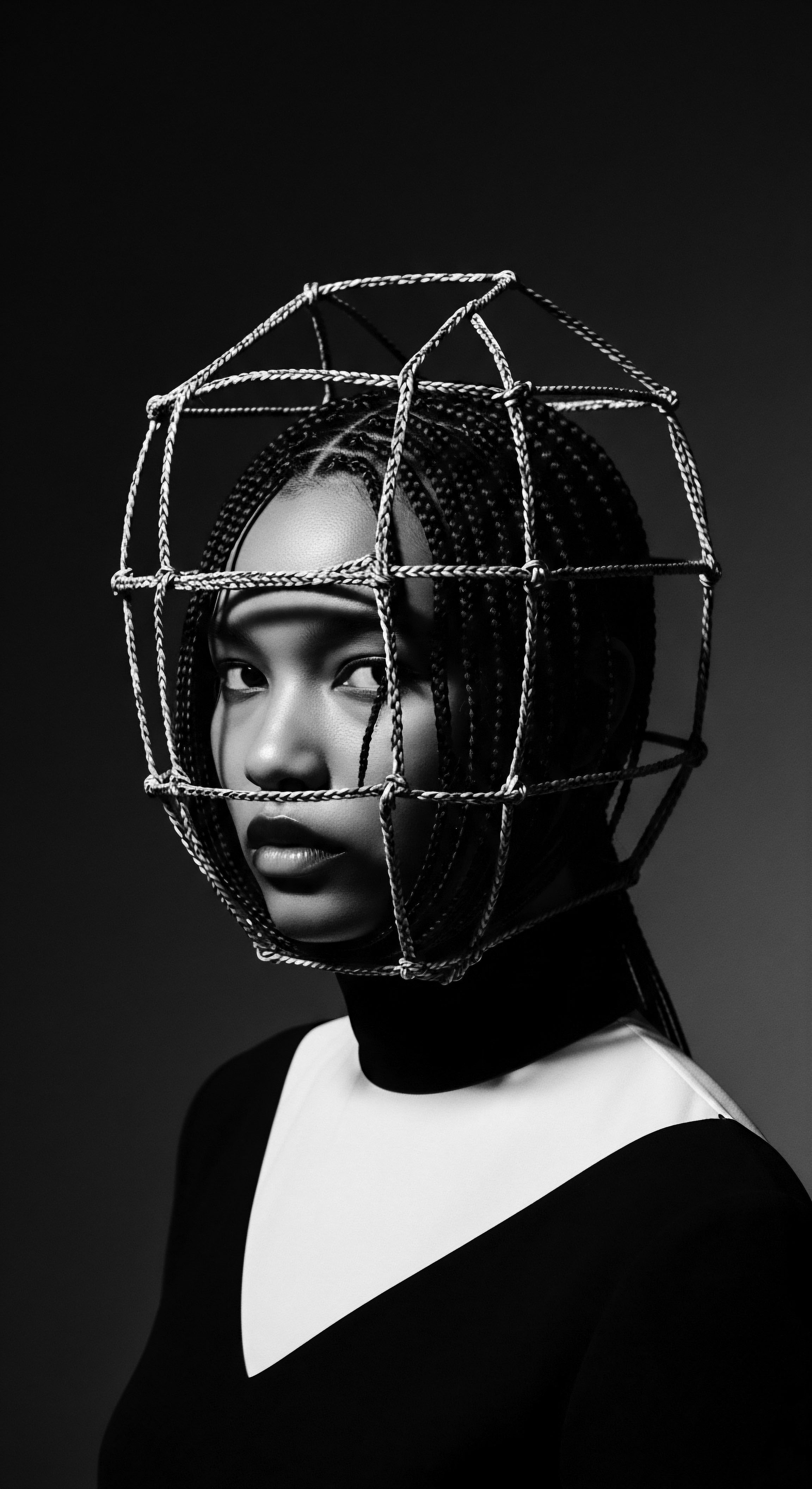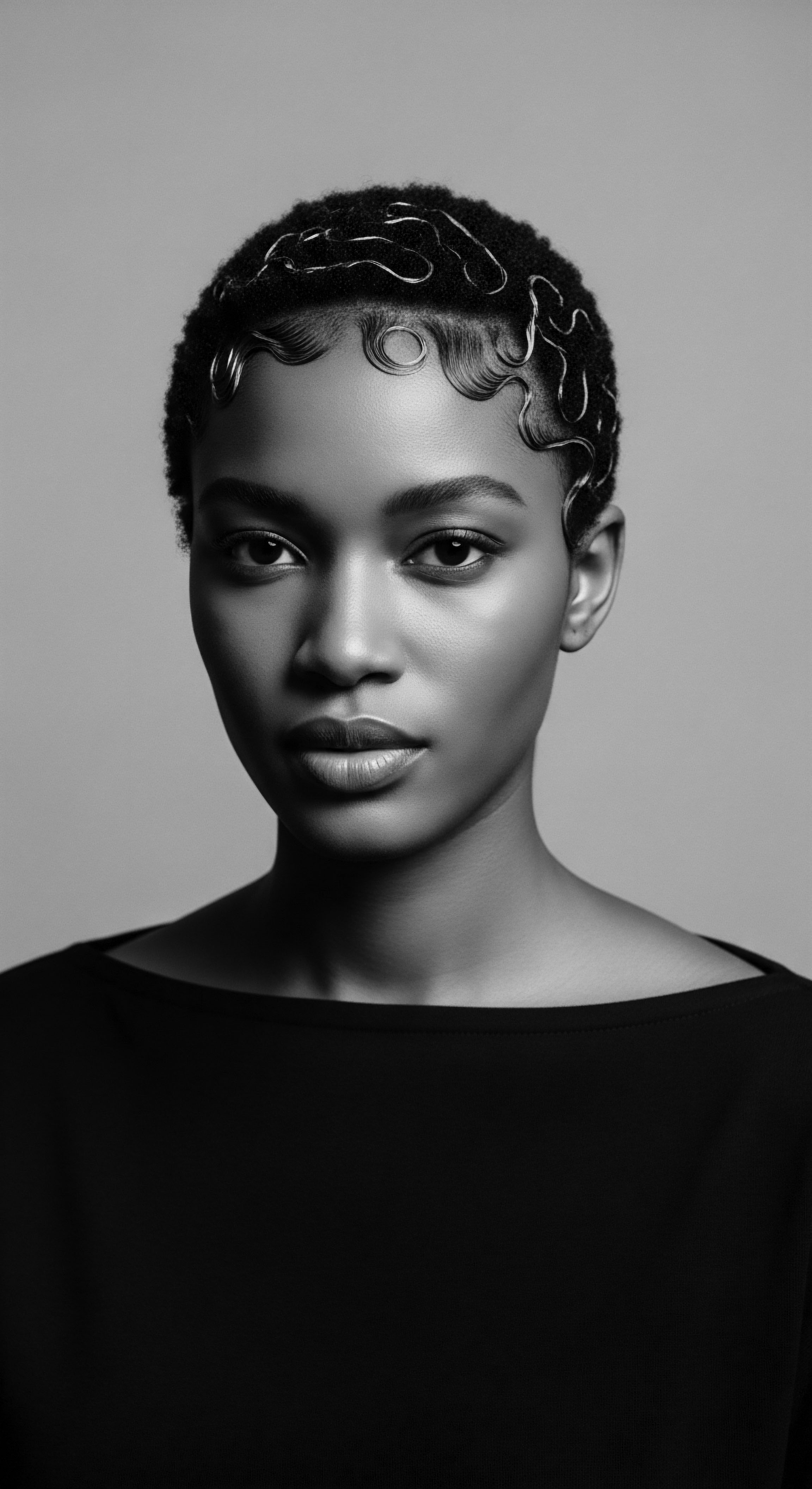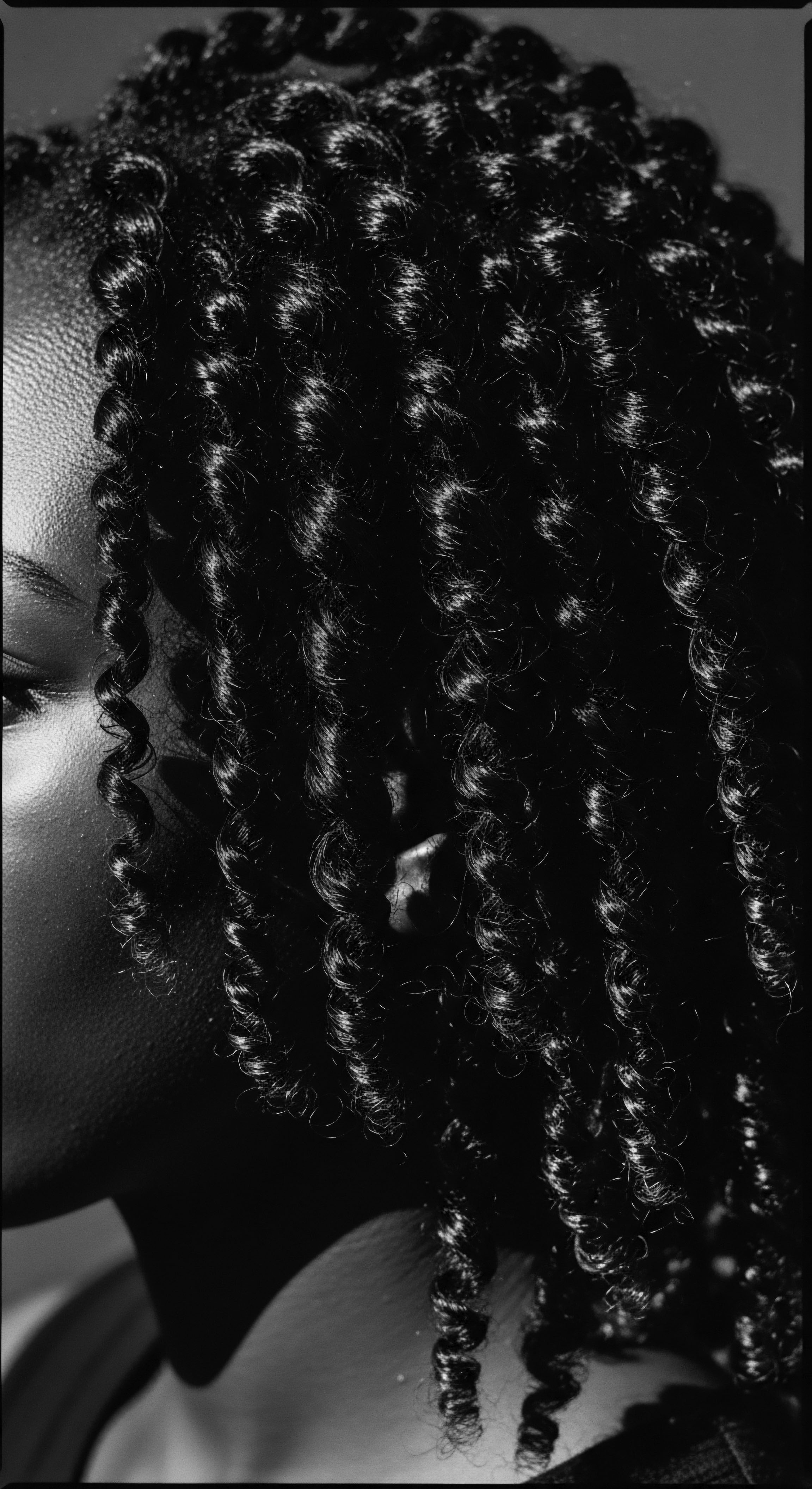
Roots
Consider the intricate dance of oil upon a strand, a silent language spoken across generations. In the heart of Black hair heritage, oils have never been mere emollients. They are whispers of ancestral wisdom, echoes of resilience, and tangible links to a past where textured hair was a crown of identity, story, and communal bond. This isn’t just about the physical application of a substance; it’s about the profound cultural and historical weight carried within each drop, nourishing not just the hair, but the very spirit.
The journey of oils in Black hair care begins in the vibrant mosaic of pre-colonial Africa. Here, hair was a powerful marker of status, age, marital state, tribal affiliation, and even spiritual connection. The elaborate styles, often taking hours or days to create, were communal acts, fostering bonds between women. Within these rituals, natural oils and butters played a central role.
They provided essential moisture, protection from harsh climates, and contributed to the health and manageability required for such intricate designs. Early communities understood the intrinsic properties of their local botanicals, long before modern science could analyze fatty acid chains or vitamin content. This traditional knowledge, passed down through oral traditions and hands-on practice, became the bedrock of hair care practices that would journey across oceans and endure through immense hardship.
Oils served as fundamental elements in ancestral African hair care, grounding styles and community practices.

Elemental Biology and Ancestral Care
Textured hair, particularly the tightly coiled and curly types prevalent in Black communities, possesses a unique anatomical structure. Its helical shape means that natural oils produced by the scalp, known as sebum, struggle to travel down the hair shaft effectively. This leaves the hair more prone to dryness, breakage, and fragility.
Historically, African communities, keenly aware of these properties, adapted their care routines. They sought external sources of lubrication and nourishment from their environment.
- Shea Butter ❉ A true gift from the shea tree (Vitellaria paradoxa), particularly abundant in West and Central Africa. For millennia, women have harvested, processed, and utilized shea butter. Its rich fatty acid composition makes it an exceptional moisturizer, protecting hair from the sun, wind, and dust. Traditional production, often a communal endeavor, emphasizes its deep cultural significance, extending beyond beauty into areas of fertility, protection, and purity. Cleopatra herself is said to have used shea oil for skin and hair care.
- Palm Oil ❉ Sourced from the African Oil Palm (Elaeis guineensis), palm oil has a documented history of use in West and Central Africa dating back 5,000 years, with archaeological evidence of its presence in ancient Egyptian tombs from 3000 BCE. Applied to hair, it helped reduce hair loss and slow the appearance of graying, offering both protective and restorative properties.
- Castor Oil ❉ Though its journey to the Caribbean was tied to the transatlantic slave trade, castor oil’s roots are in ancient Africa, where it was used for medicinal and beauty purposes over 4,000 years ago. Its thick, viscous nature made it a potent conditioner, promoting hair growth and vitality, especially in Jamaican Black Castor Oil, derived through a unique roasting process.
The application of these oils was not a casual act. It was a methodical ritual, often involving warming the oil, massaging it into the scalp, and working it down the hair strands. This process not only distributed the beneficial properties of the oils but also stimulated the scalp, promoting circulation and overall hair health. Such practices reveal a deep understanding of hair needs, long before the advent of modern dermatological science.

Ritual
The journey of oils in Black hair heritage flows from ancient sustenance to the very fabric of identity. The ritualistic application of these botanical treasures transformed daily care into an act of self-preservation and cultural affirmation, especially as people of African descent navigated new, often hostile, landscapes. These practices were not static; they adapted, absorbed, and persisted, shaping how textured hair was maintained and celebrated across the diaspora.

How Did Ancestral Hair Oiling Adapt in New Environments?
The transatlantic slave trade presented an unprecedented challenge to Black hair traditions. Stripped of their tools, native oils, and the communal time for intricate styling, enslaved Africans faced severe conditions that damaged their hair and scalp. European enslavers often shaved heads, a brutal act designed to erase identity and humanity. Despite these efforts, hair care rituals endured, albeit often in secrecy and with limited resources.
Enslaved people resourcefuly used whatever was available—animal fats, bacon grease, butter, and even kerosene—as substitutes for their traditional oils and conditioners. This speaks volumes about the intrinsic value placed on hair and the determination to maintain a connection to heritage.
These makeshift applications, while necessary for survival and cleanliness, underscored a desperate need for moisture and protection. The tight coiling of Black hair, as noted by researchers, made it susceptible to matting and tangling when neglected. Oils, even rudimentary ones, became crucial for managing hair, preventing breakage, and facilitating basic cleanliness in unimaginably difficult circumstances. This period of adaptation, born of constraint, cemented the deep, pragmatic connection between oils and the survival of textured hair.
| Historical Period Pre-Colonial Africa |
| Significance of Oils Used as central components in elaborate styling rituals to signify status, tribe, and spiritual beliefs. Oils provided moisture, protection, and enhanced manageability for complex styles like braids and locs. (Tharps, 2021) |
| Historical Period Transatlantic Slave Trade |
| Significance of Oils Scarcity led to the resourceful use of animal fats and available cooking oils for basic maintenance, preventing matting and retaining a semblance of cultural connection amidst dehumanization. |
| Historical Period Post-Emancipation & Early 20th Century |
| Significance of Oils Pioneering Black entrepreneurs like Annie Turnbo Malone and Madam C.J. Walker formulated commercial hair products, heavily incorporating oils, to address hair and scalp health needs, often damaged by harsh straightening methods. (Bundles, 2001) |
| Historical Period The enduring role of oils in Black hair heritage is a testament to cultural resilience and adaptation across centuries. |

Pioneering the Modern Hair Industry ❉ Oils and Empowerment
The late 19th and early 20th centuries saw the emergence of Black women as groundbreaking entrepreneurs in the beauty industry, directly addressing the unique needs of textured hair. Annie Turnbo Malone and Madam C.J. Walker stand as towering figures, their innovations deeply rooted in the historical use of oils. Malone, having seen the damage caused by straightening hair with animal fats and harsh chemicals, created her “Wonderful Hair Grower” by 1900.
This product, and others in her Poro Preparations line, aimed to promote healthier hair and scalp. Madam C.J. Walker, a former sales agent for Malone, developed her own formulas, including “Madam Walker’s Wonderful Hair Grower.” Her products, often containing ingredients like coconut oil, beeswax, and sulfur, were designed to heal scalps and stimulate hair growth, not solely to straighten hair.
These formulations, steeped in oils, represented more than just beauty products; they were instruments of self-care and economic empowerment. They created a pathway for Black women to attain financial independence as agents and beauticians, distributing products and knowledge within their communities. This historical period underscores a critical shift ❉ oils transitioned from household remedies to commercially produced solutions, yet their core purpose of nourishing and maintaining textured hair remained constant. The “Walker System,” for example, actively promoted the use of oils alongside hot combs, emphasizing healthier hair over mere alteration.
From survival on plantations to entrepreneurial innovation, oils have remained a constant in Black hair care, symbolizing adaptation and empowerment.

Relay
The legacy of oils in Black hair heritage extends far beyond simple conditioning; it is deeply interwoven with movements of identity, self-acceptance, and cultural reclamation. As societal perceptions of Black hair have shifted, so too has the conscious intention behind the use of oils, moving from discreet care to a celebrated act of ancestral connection and personal expression.

How Did the Natural Hair Movement Redefine the Role of Oils?
The mid-20th century witnessed a powerful cultural resurgence with the Civil Rights and Black Power movements. This era also birthed the first wave of the natural hair movement, where styles like the Afro became potent symbols of Black pride, empowerment, and defiance against Eurocentric beauty standards. This period marked a conscious rejection of chemical relaxers and heat-based straightening methods, which had often caused damage to textured hair.
As Black men and women embraced their natural textures, oils re-emerged with renewed significance. They were not merely functional; they became integral to the philosophy of natural hair. Oils like coconut, olive, and jojoba gained prominence, lauded for their ability to moisturize, define curls, and promote healthy growth without altering the inherent structure of the hair. The emphasis shifted to working with the hair’s natural inclinations, rather than against them.
The second wave of the natural hair movement in the early 2000s, propelled by digital communities and social media, further solidified the role of oils. Online platforms facilitated the sharing of knowledge, techniques, and product recommendations, elevating traditional oiling practices to mainstream conversation within the Black beauty sphere. This shared understanding highlighted the deep scientific validation of these ancestral practices, affirming that what was done for generations also held tangible dermatological benefits for textured hair.

Oils as a Tool for Connection and Self-Acceptance?
The continued use of oils, such as Jamaican Black Castor Oil, reflects a profound connection to ancestral practices. This particular oil, brought to the Caribbean through the transatlantic slave trade, became a staple for both medicinal and beauty purposes among enslaved Africans. Its cultural significance lies in its ability to support hair health and its embodiment of resilience, adapting and preserving cultural practices under challenging circumstances.
For many, the act of oiling textured hair today is a deliberate ritual. It’s a moment of grounding, a silent nod to the ingenuity of ancestors who cared for their crowns with natural resources. This practice transcends mere cosmetic application; it becomes a form of self-care infused with historical memory, a conscious rejection of beauty standards that historically devalued Black hair, and a celebration of its unique structure and heritage. The feeling of oil being massaged into the scalp, working its way down each curl, is a physical connection to a continuum of care that has been passed down, adapting and enduring through time.
- Jojoba Oil ❉ While originating in indigenous American cultures, its functional similarities to sebum—the scalp’s natural oil—made it resonate strongly with Black beauty traditions, particularly during the “Black is Beautiful” movement of the 1970s. Choosing jojoba became an act of resistance against Eurocentric ideals.
- Coconut Oil ❉ Widely available and used for its moisturizing and frizz-fighting properties, its inclusion in modern formulations for textured hair connects to ancient uses of natural botanicals for hair health. (Phong et al. 2022).
- Rosemary Oil ❉ While perhaps less historically central than shea or palm oil, its contemporary popularity for stimulating hair growth draws parallels to the ancestral desire for robust, healthy hair, showcasing how traditional care evolves with new understanding.
The conversation around oils in Black hair heritage is multifaceted. It acknowledges the historical ingenuity, the challenges faced during enslavement, the entrepreneurial spirit that built industries, and the profound cultural statement made by simply nourishing and celebrating one’s natural textured hair. The selection of oils, the methods of application, and the very act of engaging in hair care become deeply symbolic, carrying the weight of centuries of heritage.

Reflection
The whispers of ancestral wisdom echo in every drop of oil, every careful finger-stroke through a textured strand. Oils in Black hair heritage are more than products; they are living testaments to an enduring legacy of ingenuity, resilience, and profound self-love. From the shea trees of West Africa to the castor plants cultivated in the Caribbean, these natural gifts have always served as a bedrock of care, transforming necessity into ritual, and ritual into identity.
The journey of these oils, mirroring the journey of Black people across continents and generations, speaks to a deeply rooted understanding of textured hair’s unique needs and its symbolic power. As we continue to honor and celebrate the beauty of textured hair, we carry forward a heritage of care, a continuous thread connecting us to those who nurtured their crowns with intention and spirit, ensuring that the soul of each strand remains vibrant, nourished, and unbound.

References
- BLAM UK CIC. (2022, September 15). The history of Black Hair.
- Bundles, A’L. (2001). On Her Own Ground ❉ The Life and Times of Madam C. J. Walker. Scribner.
- Ciafe. (2023, January 31). Shea Butter – Explainer.
- Husn Beauty. (2024, October 20). From Roots to Beard ❉ How Jamaican Black Castor Oil Transforms Grooming.
- Kuza Products. (2023, September 5). How Jamaican Black Castor Oil Transforms Hair Health.
- Livara Natural Organics. (2023, February 7). Black History Month ❉ The Rich History of Our African Hair.
- Makeup Moment. (2016, November 22). Review Madam C.J. Walker Beauty Culture Scent & Shine Oil Collection.
- New Directions Aromatics. (2017, October 5). Red Palm Oil & Palm Kernel Oil – For Hair Care & Skin Care.
- Nuevo Noir. (2024, March 16). The history of Afro hair.
- Paulski Art. (2024, February 14). The Rich History of Shea Butter and Its Origins.
- Phong, C. Lee, V. Yale, K. Sung, C. & Mesinkovska, N. (2022). Coconut, Castor, and Argan Oil for Hair in Skin of Color Patients ❉ A Systematic Review. J Drugs Dermatol, 21(7), 751–757.
- PushBlack. (2023, September 23). Why Jamaican Black Castor Oil Is Rich in Black History.
- Refinery29. (2021, February 23). The Evolution Of The Natural Hair Movement.
- Salford Students’ Union. (2024, October 29). The Remarkable History Behind Black Hairstyles.
- SHSMO Historic Missourians. Annie Turnbo Malone.
- Smithsonian Center for Folklife and Cultural Heritage. The Will to Adorn – Beauty Products.
- The State Historical Society of Missouri. Annie Turnbo Malone.
- Tharps, L. (2021). Hair Story ❉ Untangling the Roots of Black Hair in America. St. Martin’s Publishing.
- University of Michigan. Black Women and Identity ❉ What’s Hair Got to Do With It?
- Woodrow Wilson House. African American Inventors-Annie Minerva Turnbo Malone Text- MAY 2021- jackyC.
